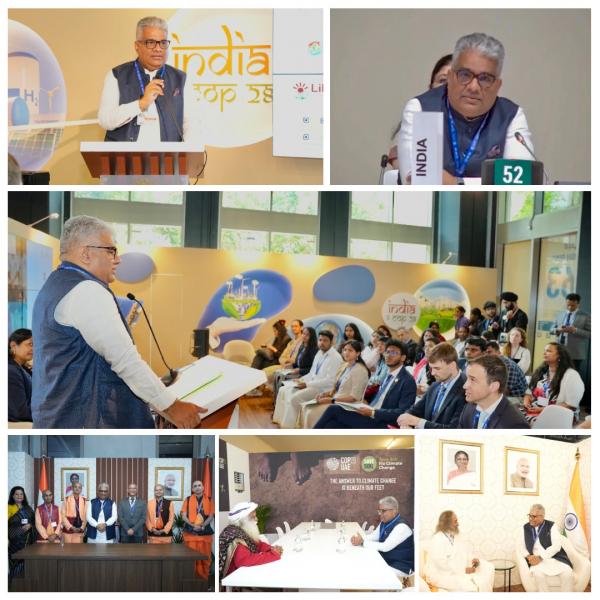
COP28 Diary: Deliberations on empowering youth with green jobs, to defining climate change
08/12/2023
BLOG
My day in Dubai today began with participation in the official launch of Green Rising: Powering Youth Action & Solutions for Climate. Green Rising is aimed at fuelling Youth-led Climate Actions and Solutions.
I stated that the young are most crucial key to attaining a sustainable world. While there is no denying the young people are among the most vulnerable groups impacted by climate change, there is also no denying that the youth are valuable contributors to climate action. They are agents of change as entrepreneurs, innovators, and environmentally conscious individuals with a will to drive positive change.
The young today are making the best use of education, science and technology to scale up their efforts to accelerate climate action. They are using their agency to compel governments world over to bring sustainability to the centrestage of governance. Addressing the gathering, I said that it is our responsibility to equip the youth with the right knowledge and skills to usher in a sustainable future. This right knowledge must include a blend of technological prowess and environmental sense. Further, I underlined that the environment needs healing and we can extend it only by tempering technology with environmental consciousness.
I stated that with Hon’ble Prime Minister Narendra Modi in the driving seat, India is marching ahead with the principle of ‘saving ecology and driving economy’ and that our country is delighted that a global beginning is being made in the direction of affecting youth-led change. It is important that joint initiatives, aimed at building the capacity of youth as future leaders and driving forces of climate regime, are undertaken.
In India, considerable efforts are being made to strengthen the adaptive capability and resilience of youth. Green jobs not only provide the much-needed employment opportunities for youth, but also act as a channel to contribute to the fight against climate change, including adopting sustainable lifestyles.
India’s communication and outreach programmes broadly focus on harmonising traditional and modern climate-friendly values and practices.
India’s National Mission for Strategic Knowledge on Climate Change, under the National Action Plan on Climate Change (NAPCC), has a focus on creating awareness and understanding regarding climate change issues, particularly among students and youths.
***
My next engagement of the day also pleasantly had to do with youth. I addressed the Youth Actions on Lifestyle for Environment, an event organised on the sidelines of COP28. The event was organised in collaboration with the International Energy Agency (IEA), UNICEF and YuWaahin at the India pavilion.
Addressing the gathering, I stated that UNICEF’s recent study shows that globally, approximately 50% of the world’s population of children, totalling around 1 billion, lives in countries that are at an ‘extremely high-risk’ of climate change. Therefore, it is critical that global commitments and national climate policies that set forth the priorities for climate response are sensitive to children.
I highlighted that the Indian government believes environment is not just to be protected, but the ecosystem needs to be restored. Our children must be able to enjoy nature in all its glory. This is not a small task and so it cannot be done by a few. It needs the individual participation of 8 billion people who inhabit Planet Earth. Hon’ble Prime Minister Narendra Modi has time and again emphasised the need to work collaboratively. International forums such as International Solar Alliance, LEAD-IT, CDRI, Big Cat Alliance and the Green Credit Initiative stand testimony to it.
Two years ago, at COP26 in Glasgow, Hon’ble Prime Minister Shri Narendra Modi announced Mission LiFE, an India-led global mass movement on positive behavioural change towards the environment. I reiterated that to be a pro-planet person, one needs to do just seven things - save water, save energy, reduce waste, reduce e-waste, reduce single-use plastics, adopt sustainable food systems, and adopt healthy lifestyles. These simple actions have the potential to substantially reduce carbon emissions and contribute to environmental sustainability.
I told the gathering that the International Energy Agency’s analysis of the LiFE initiative shows that 2 billion tonnes of CO2 emissions can be reduced through the adoption of LiFE-aligned measures worldwide.
I also expressed my happiness at the participation of four Young Climate Leaders from India Mahiya Kulsoom, Arkesh Kedar Shenoy, Manjusha Manchala, and Aswini Kumar Paital for their exceptional on-ground efforts on climate change and environmental sustainability.
***
Later in the day, I spoke at the High-Level Ministerial Dialogue on the Climate Finance regarding information to be provided by Parties in accordance with Article 9, paragraph 5, of the Paris Agreement.
Representing India on the platform, I said that we are being asked many questions. The most pertinent of them all is to agree upon and ensure the minimum short term action. The minimum short term action, in my view, is that we need to prioritize and work together for this is the very definition of “Climate Finance”. It is the most fundamental outcome we all can aim for that will automatically lay out the pathways for subsequent action towards appropriate climate financing.
I said that the lack of definition leads to a lack of trust and transparency on a matter that should be as clear as crystal.
According to the OECD, the estimate of climate finance provided and mobilized by developed countries in 2020 was about USD 83 billion as against an amount of USD 21 to 24.5 billion if the Oxfam estimates from their Climate Finance Shadow Report are taken.
The definition of climate finance that takes into account climate specificity, new and additional flows and grant based and resources at highly concessional terms is imperative. The second point that I highlighted is the relatively paltry resource flow that needs to scale up several times over- through enhanced provision and mobilization by the developed countries including through the financial mechanisms and innovative instruments that enable the mobilisation of finance by the developed countries at an affordable cost. The flow of finance has to be along with access to technology such as offshore wind, battery storage- in the absence of these, it would not be possible for the developing countries to meet their commitments on the UNFCCC and the Paris Agreement.
Biennial communication under Article 9.5 of climate finance flows under Article 9 of the Paris Agreement should be based on mutually agreed standard formats with sufficient disaggregation of the type of finance flow and what it may be meant for to allow information to be consistent, predictable, and transparent. I stated that it is imperative that we now move towards solution mode with options for us to deliberate upon.
Towards the end of the day, I met Sadhguru, Sri Sri Ravi Shankar and members of SKCON group building an ethical foundation of climate change by integrating Bhagvad Gita's teachings to empower school students in combating climate change.
